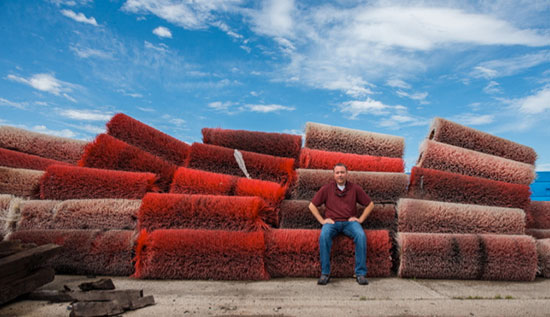Choosing Sweeping Equipment |
Repurpose Marketplace Offers Value to Buyers and Sellers
by Ranger Kidwell-Ross with Damon Carson 
REUSE: It's that all important third of the Reuse/Reduce/Recycle circle of arrows that have become so familiar. However, when considering what might be reused, it's important to consider both sides of the reuse equation.RETHINK: First, what items that are no longer needed might be submitted to the reuse/repurpose instead of being landfilled or recycled? Secondly, what needed items might you be able to procure from the reuse – or repurpose – marketplace?
Carson, who may be heard in an approximately 17-minute audio podcast by clicking the link at the bottom of this article, says his company representatives solicit industry on the topic of repurposing their waste stream by asking the simple question "Got byproducts?" If there are byproducts in an organization's waste stream, they might well be a candidate for repurposing. From the outset, Carson makes it clear his company is not in the recycling business. Rather, they collect items from the industrial waste stream and, through contacts with industries and companies looking for lower-cost alternatives, they resell the items for completely new usages. For example, says Carson, a worn rubber industrial belt may be cut into lengths for use as snowplow blades or a variety of other uses. 
As a sweeping industry example, the company is a collector of worn-out broom sweeper cores. The major repurposed use of these, Carson said, is for cattle scratching posts. For both of these example products, it means postponing the time when the items end up in a landfill. It also saves money and creates bragging rights for the companies involved in both sides of the transactions. Shown in the photo above sitting with all the broom cores is Jerry Kessler, ¸¸' Chicago branch manager. "We're interested," said Carson, "in items that can be used to have a very different second life. We call that 'repurposing.' A large conveyor belt from a coal mine won't have the same second life. Instead, it may become a snowplow blade deflector, or it gets cut as skirting for a sand dispensing machine. There are many other uses that might come up. We've seen municipalities use conveyor belt as flooring, where it's put down to put heavy equipment onto some type of surface where it's needed but where the machine would otherwise tear up the floor.
Carson's company repurposes many types of barrels; for example, 50-gallon barrels and 275-gallon totes. These are put into reuse for a wide variety of new usages. Totes, for example, are widely used for duck blinds. In the waste stream hierarchy, repurposing has a much higher position that does recycling. Whenever possible, of course, material that can be recycled should be. However, whenever something might be repurposed to another usage, that's a more important outcome than is recycling. In the case of street sweeping departments, mechanical broom cores are a large wear item that need disposal at the end of their usable lifetime on a sweeper. Cost for keeping those and other no longer needed items in circulation through the company – instead of putting them in a landfill – varies widely. Like any other economic transaction, the demand for the second usage will play a factor. Also adding to the cost will be shipping/transport to one of repurposedMATERIALS' three locations, or to elsewhere. "We know we can save an organization its landfill charges," said Carson. "And, we can give organizations bragging rights with their customers and/or constituent base when they provide media outlets with information about what you have repurposed. That's the 'feel good' kind of articles that newspapers like to publish about their local government agencies. It's easy to get bad press every time a water main breaks. When you repurpose your waste stream, it gives agencies and companies an opportunity for positive press." Shipping, Carson says, is always less expensive if you can stockpile at least half a semi-load of whatever the items might be. Or, if you're close enough to one of their locations, you can deliver them yourself to bring the expense down. One of the municipalities from whom they receive broom cores, for example, stockpiles the cores until it gets 50. That minimizes the shipping portion of the transaction. I encourage anyone reading this to rethink the outcome when they consider their organization's waste stream. If you are getting rid of items that fit the repurposing profile of being generic, versatile and adaptable, then give repurposedMATERIALS or another, similar, organization a call letting them know what you have. Actually, even better is to send photos, along with descriptions, location, dimensions, amount and any other information you think would help the company representative understand what you have. "It's interesting how a resourceful, smart project manager can find a used material from some other industry and find a use for it within the municipal sector," said Carson. "Parks and Rec. Departments, especially, seem to be able to find creative uses for repurposed material. Another example with repurposed belting we've seen is for use at the bottom of the chain link fencing at the backstops of baseball fields. We operate at the intersection of affordability and sustainability, where you get the advantages of both pluses by repurposing."
If you'd like to contact Damon Carson, send an email to damon@repurposedmaterialsinc.com. repurposedMATERIALS, Inc. may be reached by calling 303.321.1471. You can also sign up for the repurposedMATERIALS newsletter by following this link. |
© 2005 - 2021 World Sweeper
|
Return to: |